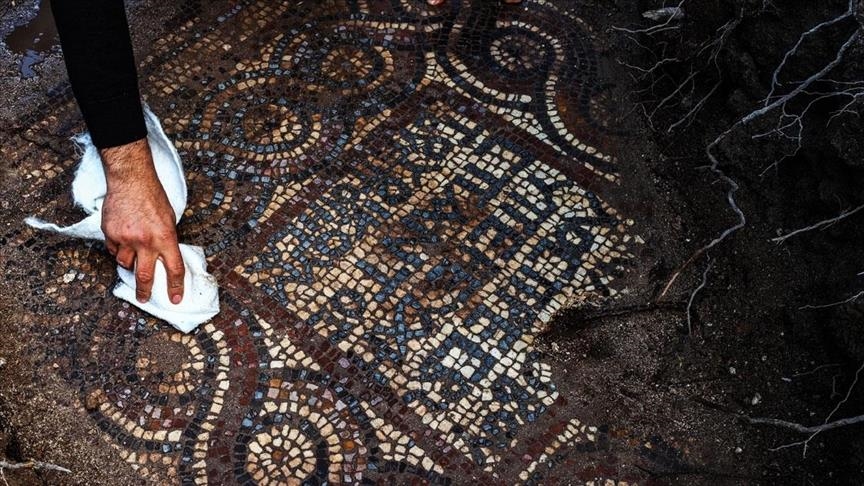Monastery, 1500-year-old mosaic unearthed in Turkey
During an illegal excavation project carried out by two suspects in the Aliağa district of Turkey’s western Izmir province, a monastery built in the Roman period and a nearly 1500-year-old mosaic were discovered.

Turkish Gendarmerie teams, acting on a tipoff, launched an operation in the mountainous area of the Aliağa district which has no vehicular access. The suspects were nabbed trying to remove the historical remains from about 2 meters (6.5 feet) below the ground.
Later, experts from the Izmir Archeology Museum investigated the region and the area was put under protection. The mosaic will be taken to a museum after initial studies are performed.

Hünkar Keser, the director of the Izmir Archeology Museum told Anadolu Agency (AA) that the team came to the region following the Turkish Gendarmerie’s notification. “We discovered the floor mosaic. This place was used as a monastery and has a basilica,” said Keser.
Explaining that the team estimates that the monastery was used between the fourth and 14th century, Keser said the mosaic was very valuable archaeologically.
“It is located at a point where it can be reached by tractor from the pathways. This is a universal cultural asset and a rare artefact,” he said.
The Incredible Images Created With Byzantine Mosaics
The Byzantine Empire refers to the continuation, in parts, of the wilting Western Roman Empire, in its eastern advancement roughly from the 5 th century AD to the middle of the 15 th century.
With its capital at Constantinople, the overwhelming influence of Eastern Orthodox Christianity appeared in all art forms during the period, including architecture. During this period, the art produced drew heavily on Hellenistic motifs and iconography, frequently with mystical themes.
Mosaics are carefully constructed colourful and detailed pictures made of finely cut marble, limestone and pebbles, known as tesserae.
The Byzantine Empire was renowned for its mosaics. And many of these incredible works of art celebrated the union of church and state.
The spread of Byzantine mosaic culture was not restricted to Constantinople but spread to distant regions of the empire, including the Balkans, southern Italy, and parts of Russia.
In fact, the rapid increase in mosaic artists who possessed the technical mastery and aesthetic sense of this artform led to huge cross-cultural influences, including Islamic art styles, especially by the Abbasids and the Umayyads.
While the messaging was politico-religious, it was impossible to ignore the distinctions in style and aesthetics and the resultant beauty.

The world-famous Hagia Sophia, now a museum, began as a church and then became an important mosque for nearly 400 years, is especially celebrated for its exceptional range of gorgeous mosaics, made by the finest craftsmen.
This is also true of the mosaics found in the monasteries at Hosios Loukas, Daphni and Neo Moni of Chios in Greece, which are all marvels of the Byzantine mosaic artform and, incidentally, UNESCO World Heritage Sites.
Due to the eventual collapse and sacking of the Byzantine Empire capital of Constantinople in the 15 th century AD, many mosaics were destroyed forever. And this was a terrible loss for historians and cultural aficionados worldwide.
Izmir itself, the location of the current find, was once the ancient Greek city of Smyrna, which became a part of the Byzantine Empire. It was ransacked several times: twice by the Turks in the 11 th and 14 th centuries, and then by the Ottomans in the 15 th century.
The recently discovered Roman monastery mosaic will be removed from the ground and taken to the museum for further study. It is a find that has great historical implications, and it is only a matter of time before we learn more.
